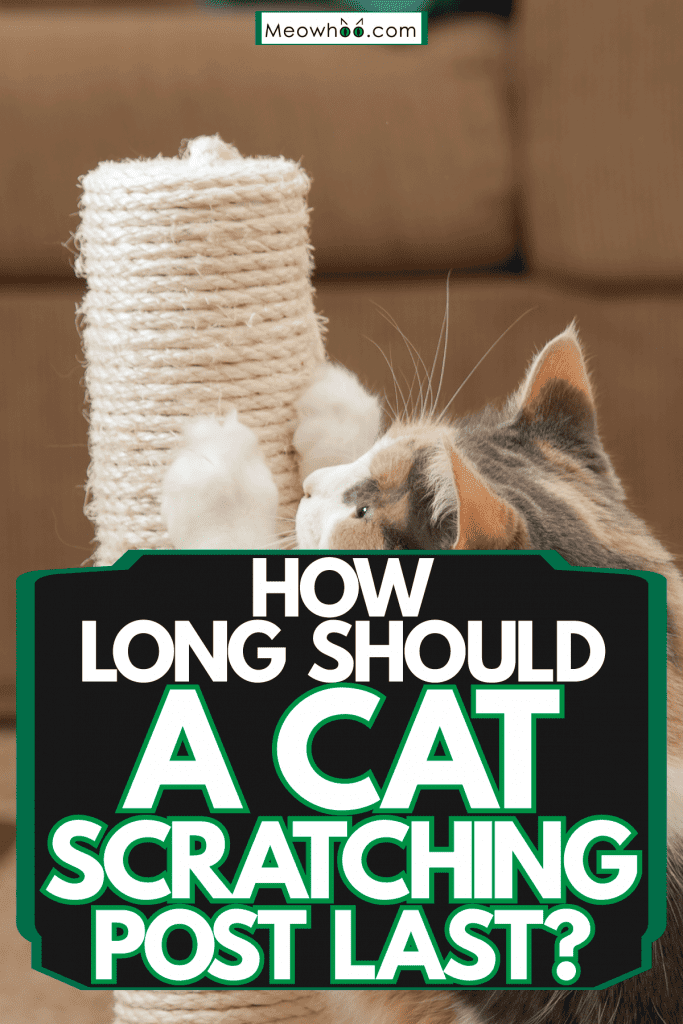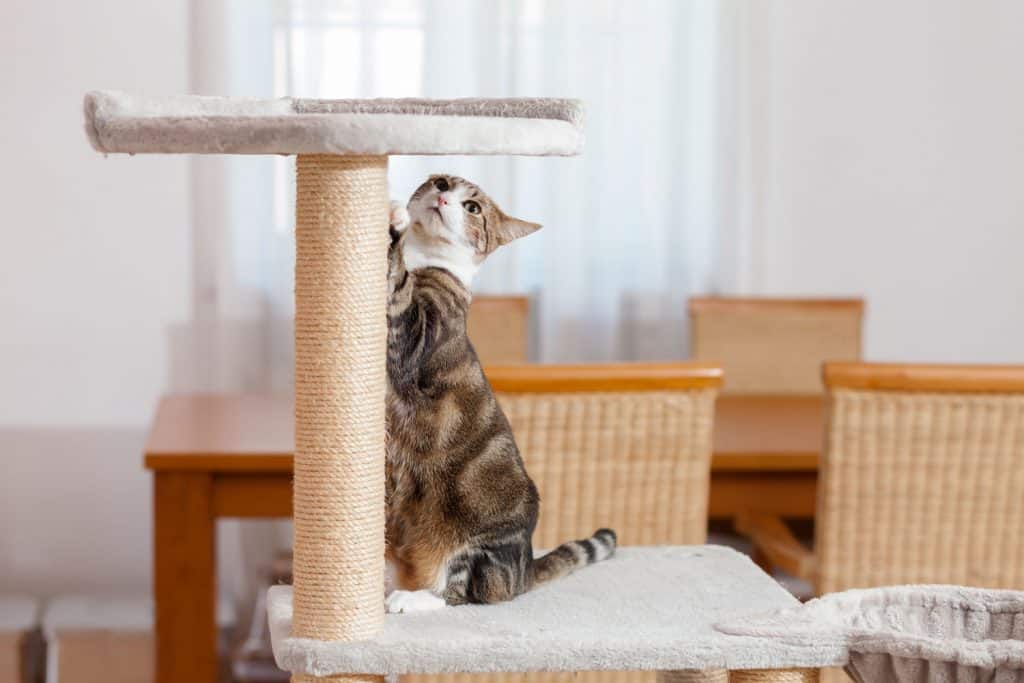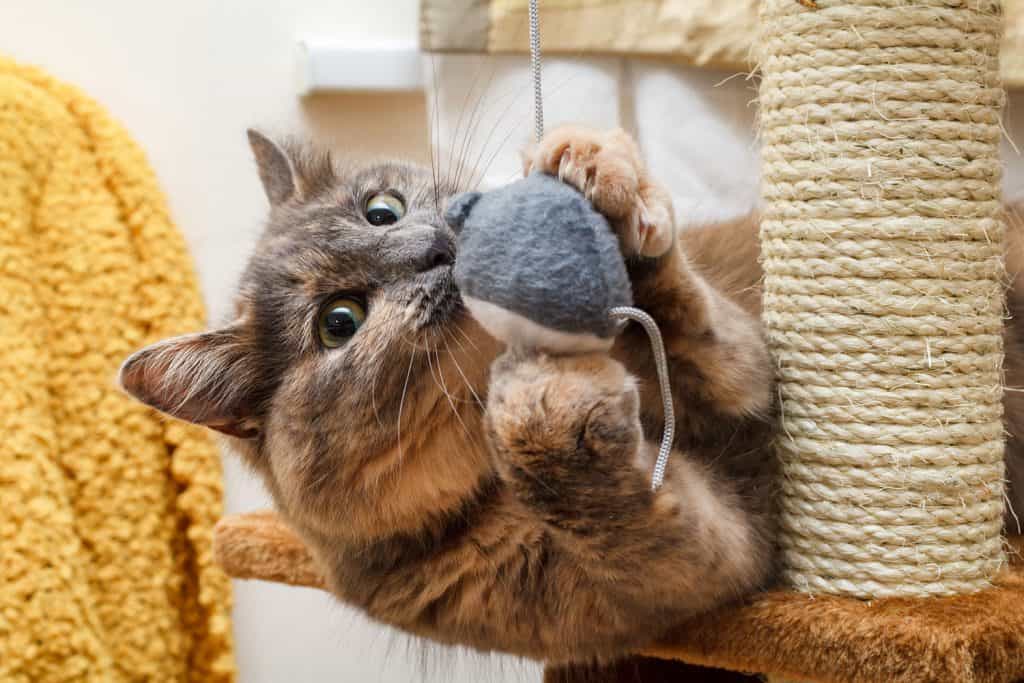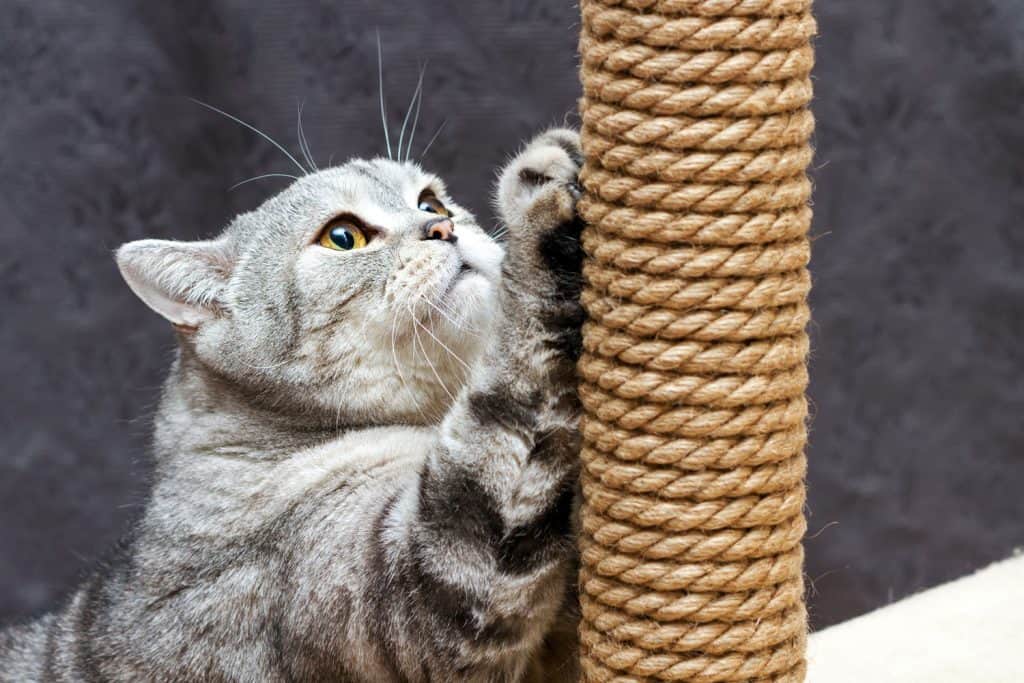Scratching posts keep cats entertained and healthy. However, the cycle of replacing and discarding them varies according to different factors. If you’re not sure about when to replace scratching posts or how to make them last longer, keep on reading because we made this post for you.
A scratching post’s typical lifespan is 6 months to 2 years. However, replacing it may be earlier than expected if you notice that 1) your cat suddenly ignores its current scratching post or 2) it has become unsafe and unusable. Buy a new one as soon as it cannot hold up to your cat’s activity level or refurbish it with sisal rope to make it last longer.
Choosing the scratching post that suits your cat’s activity level varies over time. So, we gathered a few more details to help you decide the best time to replace it and included some tips on how you can take care of your cat’s scratching posts.

When should you replace a scratching post?
The two sure signs you need to replace your scratching post immediately are:
- When they are totally worn-out and dangerous
- When your cat changed its behavior towards its current scratching post
Out of the two, the second sign needs cautious monitoring and the best way to predict the timing of replacing scratching posts is by studying the following factors:
Number of cats

The longevity of scratching posts depends largely on how many cats use each post on a daily basis.
Ideally, each cat must have at least two scratching posts. Therefore, if you have 3 or more cats, you have to monitor the replacement for each cat post.
When you have multiple cats and they don’t get along, they tend to scratch more to mark their territories.
For cats, providing choices is important. Therefore, giving them sufficient scratching posts prevent your household furniture from being ripped apart in no time.
Cat’s Individual activity level
They begin scratching when they turn 8 weeks old so training them is a big plus.
According to research, “the ideal scratching post includes rope as a substrate, is upright vertical, 3ft or higher, has two or more levels and a base width of between 1 and 3 ft.”
Understandably, such a conclusion may not exactly fit your cat’s unique activity level which was affected by age, breed, personality, and environment-induced temperament.
For example, anxious cats have more intense scratching needs so they need sturdy scratch materials.
Type, quality and size of the scratching post

When it comes to material, sisal scratching posts are durable and moisture resistant. Carpet scratching posts are preferred by older cats (10 years old and up). They can be used as a distraction but they cannot provide cats full comfort the way cardboard scratchers satisfy them.
Many feline parents love cardboard scratchers because they are inexpensive but actually cats love them because the texture is softer than sisal scratchers. In contrast, cardboard scratchers need to be replaced frequently
Depending on the cardboard scratcher’s strength and size, its average service time is between 3 and 4 months. Some last a month with constant use. A high-quality cardboard scratcher lasts about 6 months especially if it is reversible.
Design and location of the scratching post
The lifespan of scratching posts can be prolonged by distributing them in locations preferred by your feline friends.
Cat owners should consider their pet’s territorial habits in choosing the locations of their cat’s scratching posts.
Unfortunately, some scratching posts do not complement the aesthetic of the cat owner’s home.
To strike a balance between your cat’s needs and your home’s design, consider the following scratching posts by directions:
- Horizontal scratch posts take up much space but they help cats with weight problems
- Cats love stretching so vertical scratch posts are ideal especially if its size can accommodate the entire length of a cat’s body.
- Angled scratching posts fit in small spaces and are enjoyed by most cats regardless of weight and height but they don’t provide some cat breeds full scratching experience while standing.
For a more detailed description of the different types of scratching posts, check out this link.
What can you do with old cat scratching posts?
Although worn-out scratching posts are unsightly, cats prefer them because they have their scent on them. You can actually revive them by attaching a sisal rope to them.
Before you discard them, increase the appeal of the new cat post first. Here’s how:
- Place the new one beside the old scratching post.
- Give your cats some treats whenever they use the new cat post to let them know that they are doing the right thing.
- Rub their scent from the old post to the new post using a clean sock.
In this way, when the old scratching post disappears, your cat won’t feel lonely.
Can you replace a scratching post on a cat tree?
Scratching posts on a cat tree can be replaced. The best material to use is sisal fabric because it is strong and rough. It has a similar consistency to a tree bark that most cats love.
How do you refurbish a cat scratching post?

Fixing your cat’s scratching post with a sisal rope is a top suggestion.
To repair the tattered rope or scratching area, you’ll need pliers, scissors, non-toxic cleaners, a glue gun, staple gun, and sisal rope.
Thoroughly clean the scratching post first. You may use a vacuum to clean it fully especially if your cat post is made of wood covered with sisal rope or a carpet. On the other hand, wet cleaning will not prolong the lifespan of your cardboard scratching post.
Cut the worn-out section of the scratching post.
In removing the old sisal rope, start at the top of the post. Eliminate all the staples as you remove the old sisal rope down to the bottom of the post.
When you attach the new sisal rope, start at the bottom of the post. Secure it by using staples every one to two inches around the first layer of rope. Then, use a glue gun in doing the rest of the scratching post. Don’t forget to wrap the rope tightly around it.
Cut the excess rope and again, secure the last layer with staples every one to two inches.
How often should I replace my cat’s scratching post?
Replacing your cat’s scratching post depends largely on your cat’s use. If your cat has sufficient scratching posts, it may last from 6 months to 2 years.
Should I throw away an old scratching post?
You can make an old scratching post look brand new by replacing the worn-out section with sisal rope or sisal fabric.
Should I tie a sisal rope to a new scratching post to make it last longer?
Wrapping sisal rope to a new scratching post does not guarantee longevity if your cat’s scratching needs are intense. Depending on your cat’s use, it may need replacement earlier than its approximate lifespan of 6 months to 2 years.
Summary
Feline parents prefer cardboard scratchers because they are inexpensive but for cats, sisal fabric provides the most satisfying scratching experience.
The average service time of cardboard scratchers is between 3 and 4 months so depending on the cat’s use, they should be replaced at least four times a year.
On the other hand, old scratching posts that are covered with sisal or carpet with wood underneath can be refurbished. Feline parents can use sisal rope or sisal fabric to revive them.
Lastly, the best way to make scratching posts last longer than 2 years is to pay attention to your cat’s activity level so that you can catch up with their scratching needs.
Some elements on this page may have been created by our team using advanced AI to provide you with top-notch cat inspired ideas. Read more about our AI Content Policy.
